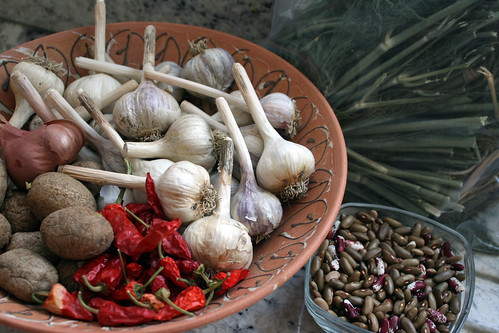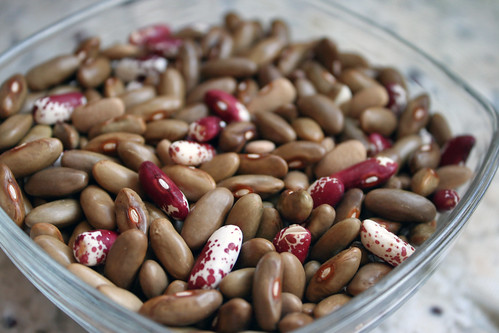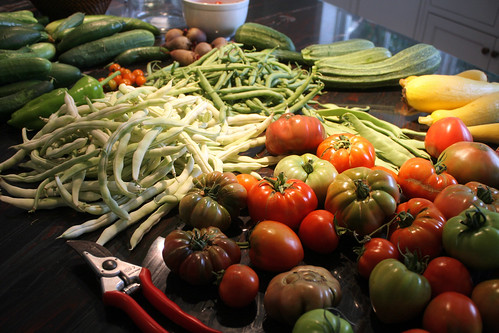Kamis, 11 Desember 2014
january larder
 I have a pretty minimal larder this year. Mostly because I spent more time cleaning the house and seeding the grass so we could sell our house last summer. The good news is - we have a beautiful new home. And the bad news - I have to go to the grocery store a lot more than Id like.
I have a pretty minimal larder this year. Mostly because I spent more time cleaning the house and seeding the grass so we could sell our house last summer. The good news is - we have a beautiful new home. And the bad news - I have to go to the grocery store a lot more than Id like. I have a good supply of garlic - I got that crop in the ground before we started the home-selling stuff. Its really nice, with big cloves and holding fine (even though we dont have a cool place to store it - thats another story: our new house doesnt have a basement yet. Well build one this spring.)
I also have a couple nice shallots left. (I grew shallots for the first time last year and was really pleased with these. Ill grow them again this year.) I have a lot of dried chilis. I grow a cayenne and a Thai hot chili every year. These thin-walled chilis air dry easily on a plate my counter top. I also have a couple bags of dried herbs. These are plants I cropped short when we left our old house. I have dill, sage and oregano.
And I have a little bowlful of dried beans. I tried to grow crops of Jacobs Cattle beans and black turtle beans, but only ended few of the former. And, then I grew Fortex green beans, but didnt harvest them in time so they matured and dried. So I have a fairly unattractive and very small bowl of dried beans. Nevertheless, Im saving them and looking forward to a special chili meal.

 I do have great plans for next years larder (“A garden is never so good as it will be next year" - Thomas Cooper ). I am hoping for shelves full of canned fruits, tomatoes, pickles, dried chilis and herbs, baskets full of potatoes, sweet potatoes, squashes and dried beans, a fridge full of beets, cabbages and carrots, and maybe even a freezer with pesto and roasted peppers. OK, a few winter radishes too for my martinis....
I do have great plans for next years larder (“A garden is never so good as it will be next year" - Thomas Cooper ). I am hoping for shelves full of canned fruits, tomatoes, pickles, dried chilis and herbs, baskets full of potatoes, sweet potatoes, squashes and dried beans, a fridge full of beets, cabbages and carrots, and maybe even a freezer with pesto and roasted peppers. OK, a few winter radishes too for my martinis....Rabu, 10 Desember 2014
New Layout
My title photo was looking a little frumpy and off center so I decided to do something about it. I photoshoped the photo and re-sized it to actual fit. After that the photo looked like it didnt fit so I found a new template that is more toned down in terms of colour. I think I am pleased now but still not 100% sure. Any ideas for changes?
I also have a post up about the fence I am building below:
Read More..
I also have a post up about the fence I am building below:
Gardening as a creative activity
I guess Ive always thought that gardening was creative, but it wasnt the first thing I thought about in a 12-week class focused on the book, The Artists Way (Julia Cameron).
I thought I wanted (and needed) to draw, paint, and do watercolors and pastels to be an artist. Well, I know those activities are wonderful, and Im trying to find the time to play with some of those media, but... in the meantime, Ive also realized that writing, photography, blogging, and gardening are equally compelling creative pursuits.
As part of each book chapter, there are LOTS of tasks - which our facilitators encourage us to do.
Yikes. Its a lot of work (and soul-searching) in the process, but its concentrated my attention on how much my surroundings (garden) and creative space (whether called a study or studio) are important.
I love the view from my study at home in the Piedmont (the header view), and Ive missed that sense of place a bit this summer in the mountains (although there are many other wonderful aspects, and Im totally grateful for being able to have the space and time!)
Im hoping to build a small garden studio below the cottage in the mountains. It would look out into the forest and be surrounded by native woodland wildflowers.
Ive certainly been reminded of how creative gardening is as an activity and how important it is to have a sense of place and being supported in your surroundings.
Read More..
I thought I wanted (and needed) to draw, paint, and do watercolors and pastels to be an artist. Well, I know those activities are wonderful, and Im trying to find the time to play with some of those media, but... in the meantime, Ive also realized that writing, photography, blogging, and gardening are equally compelling creative pursuits.
 |
| Collage as inspiration for garden studio |
Yikes. Its a lot of work (and soul-searching) in the process, but its concentrated my attention on how much my surroundings (garden) and creative space (whether called a study or studio) are important.
I love the view from my study at home in the Piedmont (the header view), and Ive missed that sense of place a bit this summer in the mountains (although there are many other wonderful aspects, and Im totally grateful for being able to have the space and time!)
 |
| Potential site for garden studio |
Ive certainly been reminded of how creative gardening is as an activity and how important it is to have a sense of place and being supported in your surroundings.
A robust trout lily
 |
| Erythronium americanum (Trout lily) |
Senin, 08 Desember 2014
Last of the Late Late TPS

Perennial meadows Piet pulls it off

Some time ago I did a post on growing perennials in grass, actually the second most read posting I have done. This is something of an unrealisable holy grail for many of us, the idea that you can have roughish grass with wildflowers and perennials growing in it. Our native grassland flora here in Britain and north-west Europe is very low on really bright ornamental species and there is so little that flowers after mid-summer. William Robinson suggested doing this in The Wild Garden, published in 1870, but he actually had very little experience of doing this when he wrote that book; in fact it was early in his career, and very much a rhetorical book rather than a practical one. It is a book which really does not deserve its reputation.
The tough reality is that in our maritime climate with its long growing season it is very difficult to get perennials established in grass. Most ornamental perennials originate from more continental climates and do not grow until temperatures reach a certain level; consequently they are dormant for the winter. Our native grasses and a few wildflower species like creeping buttercup grow at lower temperatures, which effectively means off and on through the entire winter. They inevitably take over so that any attempt at combining native grasses with ornamental perennials results in rough grass with steadily vanishing perennials. The only thing which can stop this happening is if they cannot get enough nutrients.
Three years ago, in April, I visited the Oudolfs (who live in the eastern Netherlands) on a radiantly sunny weekend. Piet was setting out a new planting, on the site of the old nursery sales area, where plants were lined out in pots. They had put down sand many years ago to provide good drainage and it was into the sand that some Calamagrostis Karl Foerster and some perennials: heleniums, asters, eupatoriums, vernonias etc. were going. Piet told me he was going to sow the intermediate spaces with a wildflower seed mix i.e. mostly grass with a native forb element.

I must say I was a bit sceptical. If I tried this at home, the grass would run rampant and swamp everything. But - three growing seasons later, it looks fantastic. Really fantastic. Really super low-maintenance fantastic. Piet has pulled it off, again!

The perennials have all formed good clumps and flower well, although at a shorter height than they would do normally. The grass and wildflower mix has formed a dense sward but with a relatively low grass proportion. In fact a lot of it is yarrow (Achillea millefolium). It is very biodiverse - simply as a wildflower meadow it would be a great success.

The reason must be the sand. Despite many years of having nutrients washed into it from the container plants in the nursery, it must still be very too low in nitrogen and phosphorus for grasses to be able to dominate. The result is a true and very rarely seen balance between perennials, with their clearly defined growing season, and grasses and other wintergreen species, which can grow all year round.

It really is a triumph, and illustrates very beautifully and dramatically that we must not give up on trying to achieve perennial meadows. Substrate is clearly everything, which is good news for those on sand, or post-industrial waste! The rest of us, on the fertile and moisture-retentive soils which gardeners and farmers have traditionally regarded as desirable, if not essential, can only look on in admiration. Or buy several lorry loads of sand.

 b
bMore pictures here.
Minggu, 07 Desember 2014
Sabtu, 06 Desember 2014
Rain in the mountains
It poured yesterday. Lots of rain. Our small bog will be happy, as will the sedum garden.
![]() It looked like a tropical rain forest.
It looked like a tropical rain forest.
Read More..
Amaranth celosia and musings about greens
Winter break in the Caribbean last year introduced me to leafy amaranth, a totally delicious cooked green.
The woman I bought it from (she had a small garden near our cottage in Dominica) called it spinach, but its actually Amaranthus viridis, a leafy vegetable thats grown throughout the Caribbean and called callalo. Its a popular Asian vegetable, too.
I posted about it after returning -- it was such a remarkably tasty warm season spinach-like vegetable, I couldnt believe it wasnt more popular here in the Southeastern U.S. I tried to grow it this summer, but was thwarted by hungry critters, who yummed up the young seedlings. Presumably woodchucks or squirrels.
But I was noticing the volunteer plants in the Childrens Garden that looked remarkably similar. Theyre Celosia, a large-plumed variety thats self-seeded abundantly for the last couple of years.
And sure enough, theyre a relative of amaranth (in the same family), and have been used in a similar way in parts of Africa, and elsewhere, too.
Interesting! Ill have to harvest some young plants tomorrow for a second trial.
The older larger leaves that I cooked as a trial for lunch today were good, but it was hard to evaluate their taste, as Id stir-fried them in sesame oil! They were quite tender, though, so promising.
Read More..
 |
| Red amaranth (from Evergreen Seeds) |
I posted about it after returning -- it was such a remarkably tasty warm season spinach-like vegetable, I couldnt believe it wasnt more popular here in the Southeastern U.S. I tried to grow it this summer, but was thwarted by hungry critters, who yummed up the young seedlings. Presumably woodchucks or squirrels.
 |
| Celosia argentea |
And sure enough, theyre a relative of amaranth (in the same family), and have been used in a similar way in parts of Africa, and elsewhere, too.
Interesting! Ill have to harvest some young plants tomorrow for a second trial.
The older larger leaves that I cooked as a trial for lunch today were good, but it was hard to evaluate their taste, as Id stir-fried them in sesame oil! They were quite tender, though, so promising.
A lovely spring day
Much cooler than normal, we had another fabulous spring day here in the Carolinas. I was whining about our exceptionally cold and rainy winter weather through late February, but March and April have been quite nice.
Weve had only a few hot spells, along with lower than normal temperatures. Now, if rainfall amounts get back up to normal - were still three inches short for the year - that would be great!
Read More..
Weve had only a few hot spells, along with lower than normal temperatures. Now, if rainfall amounts get back up to normal - were still three inches short for the year - that would be great!
A giant tromboncino squash!
This big one was hiding near a old tree stump. (I normally harvest them at the size of the one next to it). Notice its size relative to the cutting board. Yikes!
![]() Amazingly, it was still quite edible, roasted in slices with garlic and olive oil.
Amazingly, it was still quite edible, roasted in slices with garlic and olive oil.
The yard-long bean vines in the satellite garden are starting to produce -- need to knock off some aphids (their one pest) with some water.
And, all of our tomatoes love the heat and dry weather that weve had, as long as we water. Its hard to imagine all the rain that folks up in the northeastern U.S. and Midwest have experienced this summer.
Read More..
Oops, one that got away!
The yard-long bean vines in the satellite garden are starting to produce -- need to knock off some aphids (their one pest) with some water.
And, all of our tomatoes love the heat and dry weather that weve had, as long as we water. Its hard to imagine all the rain that folks up in the northeastern U.S. and Midwest have experienced this summer.
Langganan:
Postingan (Atom)
